With an endless supply of waves and unique conditions, surfing offers a wealth of techniques and manoeuvres for riders to tackle. Dipping into this ocean of skills and tricks, we’re diving into the ultimate list of surfing techniques and manoeuvres that every surfer — from beginners to seasoned pros — can appreciate and incorporate into their repertoire.
Figuring out the perfect bottom turn, mastering cutbacks, or levitating through floaters — these are just a few examples of the dynamic moves we’ll be exploring. Not only will we provide detailed explanations for each, but we’ll also offer step-by-step instructions to help you execute them flawlessly.
So whether you’re a grommet, a weekend warrior, or an accomplished wave rider, there’s something for everyone in our surfing smorgasbord.

Ready to up your surfing game in a major way? We’ve got your back. As we dive into this comprehensive guide, we’ll keep things engaging, relatable, and, at times, downright hilarious. Because, after all, what’s the point of riding a wave if you’re not having fun?
Together, let’s delve into the incredible world of surfing techniques and manoeuvres, with a storytelling style as fluid and connected as the waves we ride. From fascinating facts to thought-provoking questions, our goal is to educate and inspire surfers of all abilities, as we share our love for this exhilarating sport. So, let’s catch a wave together and ride towards surfing success!
Table of Contents
Fundamentals of Surfing
Learning the basics of surfing is essential in mastering the sport whether you’re a beginner or looking to improve your skills. In this section, we’ll cover four fundamental surfing techniques: Paddling, Duck Diving, Popping Up, and Footwork. Mastering these fundamentals will help build your confidence as you advance in the world of surfing.
Paddling
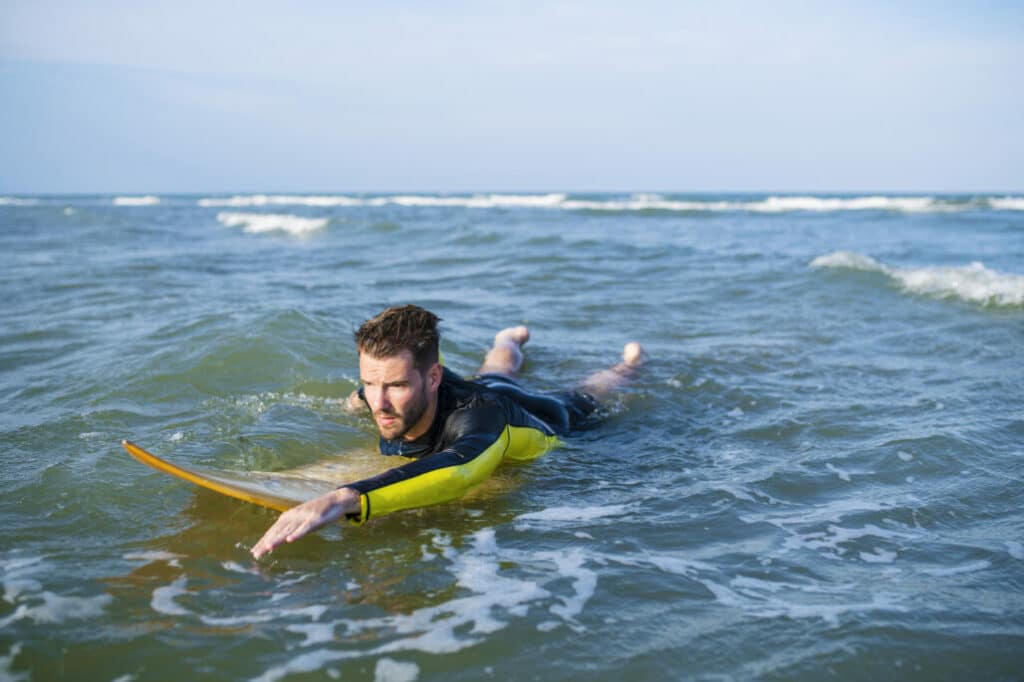
Paddling is the foundation of catching waves, and having a strong, efficient paddle technique ensures you catch waves consistently. Here’s how to improve your paddling skills:
- Align your body: Maintain a straight line from your head to your toes, keeping your head slightly raised to look forward.
- Elbow position: Create a 90-degree angle with the elbow as you reach forward, keeping your hands cupped.
- Reach forward: Every stroke counts, so reach and pull the water beneath the surface to propel yourself.
- Relax your legs: Avoid wasting energy by keeping your legs loose and toes out of the water.
Duck Diving

Duck diving allows you to dive under oncoming waves and conserve energy as you paddle out into the lineup. Developing this skill helps you move more efficiently in the water. Here are the steps:
- Approach the wave head-on and maintain some paddling speed.
- Push the nose of the board underwater using your arms just before the wave breaks.
- Kick down with your leg on the tail of the surfboard to submerge it completely.
- Allow the wave to pass over you and your board, and then resurface and start paddling immediately.
Popping Up
Popping up is the transition from paddling to standing on the surfboard. Mastering this manoeuvre is crucial for riding waves. Follow these steps:
- Start by lying on the board with your hands on the rails at chest level.
- Arch your back slightly and look towards the beach.
- Push up with both arms extending them as you prepare for the next step.
- Bring your back foot forward and plant it, followed by your front foot stepping in between your hands on the board.
- Stand up and maintain a low, balanced position, keeping your knees bent and arms out for stability.
Footwork
Footwork plays a significant role in controlling your surfboard, performing manoeuvres, and maintaining balance. Key footwork techniques include:
- Stance: Adopt a balanced, slightly crouched stance with your feet shoulder-width apart, knees bent, and arms out for stability.
- Cross stepping: Essential for longboard surfing, cross stepping involves moving your feet forwards or backwards along the length of the board to adjust your trim and achieve better control.
- Shuffling: When riding a shortboard, use shuffling to make minor adjustments to your position on the board while maintaining balance and control.
By focusing on these fundamentals, you’ll be well on your way to mastering surfing and enjoying your time in the waves.
Wave Riding Techniques
In this section, we’ll dive into some essential wave riding techniques that every surfer should know, regardless of their skill level. We’ll cover the Bottom Turn, Trimming, Pumping, and Tube Riding. So, grab your board and let’s get started!
Bottom Turn

The bottom turn is the foundation of all other surfing manoeuvres, as it sets the direction and pace for the rest of your ride. To execute a proper bottom turn, follow these steps:
- As you catch a wave, drop down its face, and lean into the direction you want to turn.
- Bend your knees and shift your weight onto your back foot.
- Dig your inside rail into the water, allowing your board to carve a smooth arc.
- As you reach the shoulder of the wave, begin to straighten your body and lean onto your front foot to transition into your next manoeuvre.
Remember that practice makes perfect, and mastering the bottom turn opens up opportunities for more advanced moves.
Trimming

Trimming is all about maintaining speed and balance while gliding along the open face of a wave. As you gain more experience, you’ll learn how to make subtle adjustments on your board to stay in the sweet spot. To trim your ride:
- Keep your knees bent and your weight centered over your board.
- Constantly scan the wave line ahead, anticipating sections that may require adjustments.
- Use your front foot to apply pressure on the rail, adjusting your line as necessary.
A well-trimmed ride will allow you to remain in control and generate speed for more advanced manoeuvres.
Pumping

Pumping is a technique used to generate speed on a wave’s face without relying on gravity. By shifting your weight and actively unweighting and compressing your body, you can generate momentum and maintain speed. Here’s how:
- Start by unweighting your body and extending your legs, pushing your board towards the wave’s shoulder.
- As you reach the shoulder, compress your body and bend your knees, shifting your weight towards the back of the board.
- Repeat these steps in a rhythmical sequence, pumping up and down the wave’s face as needed.
With practice, you’ll be able to pump through slow sections and maintain speed for more advanced tricks.
Tube Riding

Ahh, the coveted tube ride. Undoubtedly one of the most exhilarating and difficult manoeuvres in surfing, the tube ride involves positioning yourself inside the hollow chamber of a barrelling wave. Here is a basic guide to tube riding:
- Position yourself deep in the lineup, closer to the breaking point of the wave.
- As you drop in, angle your board parallel to the wave’s wall and maintain a high line.
- Keep your knees bent and your center of gravity low, allowing you to maintain balance.
- Look towards the exit of the barrel, using your front arm to adjust your line and speed.
- Enjoy the ride!
Keep in mind, tube riding takes time and practice to perfect. But when you do pull it off, it’s a feeling like no other.
Now that you’re equipped with these essential wave riding techniques, go out and conquer those waves! Remember, it’s all about practice, patience, and perseverance. Good luck and happy surfing!
Basic Surfing Manoeuvres
As passionate surfers, we know how crucial it is to master the foundation of our beloved sport. In this section, we will dive into some basic surfing manoeuvres that every surfer should know. Let’s get started on this exciting journey.
Carves

Carving is the art of performing smooth turns on the wave face while maintaining speed and flow. It is an essential skill that allows us to connect with the wave and generate speed for other advanced manoeuvres. The key to executing a solid carve lies in shifting your weight between your toes and heels while engaging your core for balance. Here are basic steps:
- Gain speed: Ride down the face of the wave to gather momentum.
- Bend your knees: Lower your centre of gravity and keep your body centred.
- Shift weight: Gradually apply pressure on your toes or heels, depending on the direction of your turn.
- Rotate the upper body: Lead with your shoulders, followed by your hips and legs.
- Complete the turn: Release the pressure to exit the carve smoothly and ride out with style.
Cutback
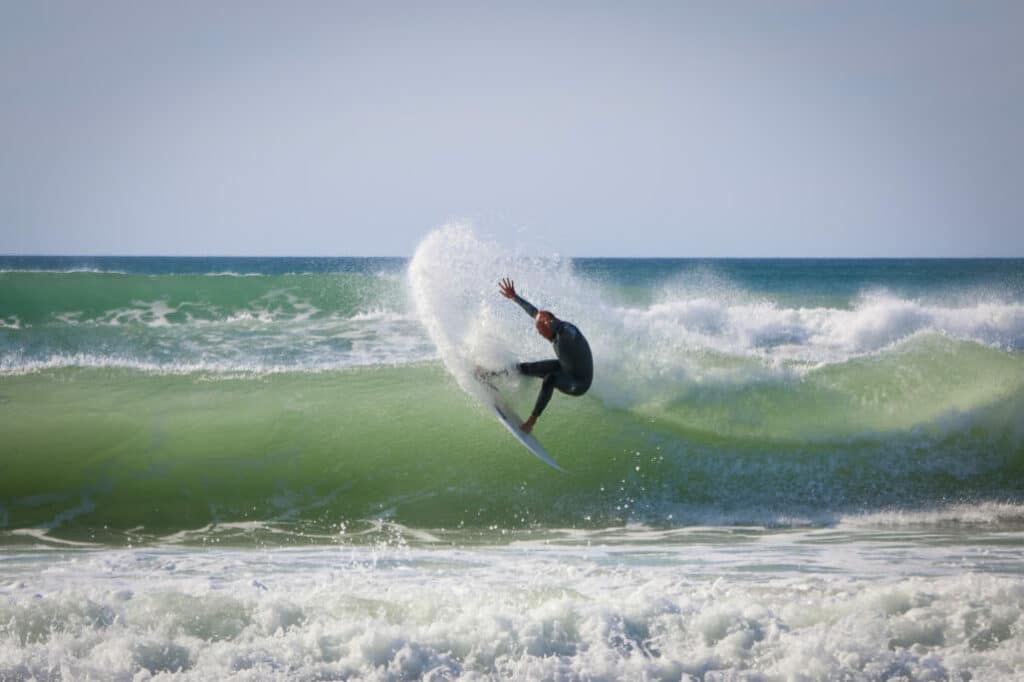
The cutback is a classic surfing manoeuvre that involves a sharp turn back towards the breaking part of the wave. With proper timing and technique, the cutback allows you to maintain your position on the wave and sets you up for your next manoeuvre. Follow these steps:
- Speed up: Approach the wave’s shoulder with sufficient speed.
- Gradual weight shift: Start transferring your weight to your back foot as you prepare for the turn.
- Upper body rotation: Lead the turn by rotating your shoulders, followed by your hips and legs.
- Throttle the rail: Lean into the turn, engaging the surfboard’s rail to carve back towards the wave.
- Finish strong: Shift your weight back onto your front foot and ride out of the cutback with confidence.
Snap

A snap is a quick, aggressive turn that generates spray and showcases your power in the surf. This manoeuvre is most effective on steep sections of the wave where you can maximise your speed and explosiveness. Here’s how to execute a snap:
- Eye the section: Identify the steep part of the wave where you want to perform the snap.
- Accelerate: Approach the section with speed and commitment.
- Compress: Bend your knees and lower yourself as you prepare for the turn.
- Rotate: Whip your upper body quickly, followed by your hips, legs, and surfboard.
- Recover: Re-centre your weight and ride out of the snap with grace.
Floater
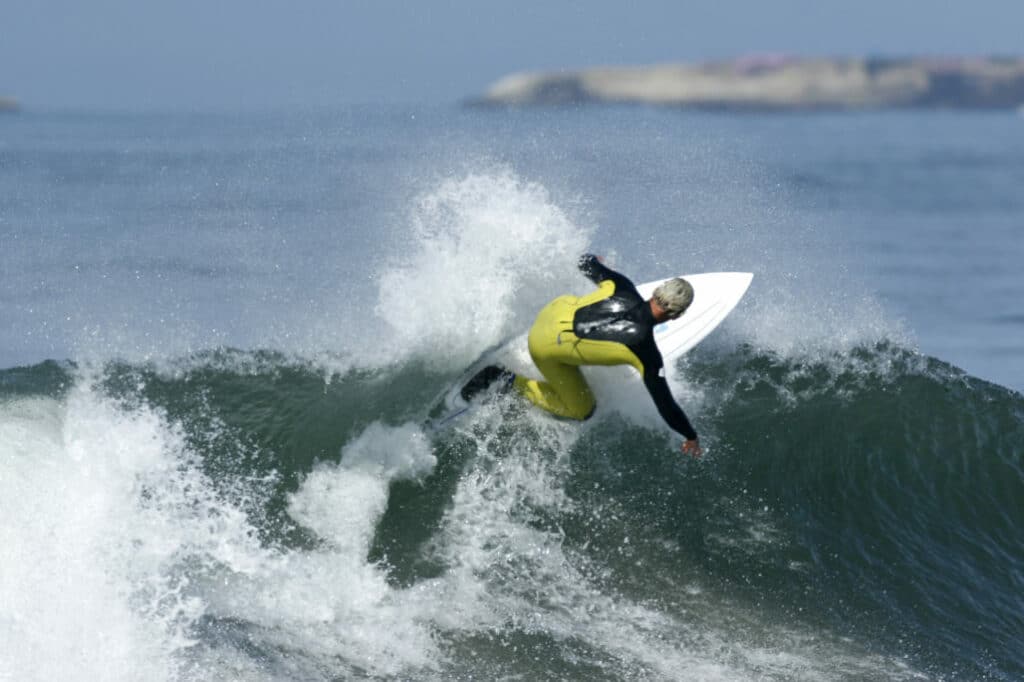
Floaters involve riding along the breaking lip of the wave, momentarily “floating” above it before dropping back down onto the wave face. This manoeuvre can be both functional and stylish when performed correctly. Here’s how to pull off a floater:
- Target the lip: Spot the breaking section of the wave where you’ll perform the floater.
- Gain speed: Approach the lip with enough speed and a slightly angled trajectory.
- Shift your weight: As your surfboard reaches the lip, transfer your weight onto your back foot and lean into the manoeuvre.
- Glide: Maintain balance and control as you glide across the wave’s lip.
- Re-entry: Shift your weight forward and gently drop back onto the wave face while maintaining your speed and direction.
These fundamental surfing manoeuvres will set you on the right path to develop your own unique style and approach to wave riding. Practice diligently, and you’ll soon find yourself tackling even more advanced moves with confidence and flair. Happy surfing!

Advanced Surfing Manoeuvres
As surfers, we know that there’s always more to learn and conquer. Let’s dive into some advanced surfing manoeuvres that will elevate your surfing game to the next level. We’ll break down each trick with step-by-step instructions, so strap in and get ready to ride!
Tail Slide
A thrilling manoeuvre that showcases a surfer’s control and finesse, the tail slide is all about displacing the tail of the surfboard across the wave’s face. Here’s how to perform a tail slide:

- Approach a steep wave section at an angle
- Compress your body by bending your knees
- Shift your weight to the back foot
- Push the tail outward, allowing it to slide across the wave’s face
- Re-engage the fins to regain control and finish the move
Off-the-Lip

The off-the-lip surfing manoeuvre is a dynamic move that involves carving up the wave’s face and snapping the board back down towards the trough. Follow these steps to execute an off-the-lip:
- Start by riding on the shoulder of the wave with speed
- Spot the lip of the wave and turn your board towards it
- As you reach the lip, apply pressure on the back foot to lift the board’s nose
- At the top of the wave, swiftly twist your body and board back down
- Brace for impact and ride out smoothly
Closeout Re-Entry
When a wave closes out, don’t just throw in the towel; go for a thrilling closeout re-entry instead! Here’s how to master this closeout re-entry technique:
- As the wave begins to close, maintain your speed and position
- Target the closing section and head straight towards it
- As you ascend, apply pressure on your back foot to lift the nose
- At the peak, turn the board by pivoting on the fins and descending
- Maintain control on the way down and ride away cleanly
Air
Aerial manoeuvres are exciting and visually striking. To pull off an air, follow these instructions:
- Gain speed and approach a ramp-like section on the wave
- Prepare for liftoff by bending your knees and shifting your weight
- As the wave launches you, focus on keeping the board level with your feet
- At the peak of your airtime, maintain composure and spot your landing
- Touch down smoothly and ride away with pride

Practice makes perfect, and with perseverance, you’ll soon master these advanced surfing manoeuvres. By adding these clever tricks to your repertoire, you’re not only stepping up your game but also inspiring other surfers around to raise their bar. Happy surfing!
Progressive Surfing Tricks
In this section, we’ll dive into some progressive surfing tricks that you can aspire to master. We’ve included a variety of maneuvers to challenge and inspire surfers of all abilities. So let’s take a closer look at these advanced tricks and what it takes to nail them!
Alley Oop
The Alley Oop is an aerial manoeuvre that involves rotating your surfboard 180 degrees while in the air. To execute this trick:
- Approach the wave with speed and angle your board towards the lip.
- As you hit the lip, push your back foot and apply pressure to your tail.
- While in the air, rotate your board and body 180 degrees.
- Tuck your knees and spot your landing.
- Land with your board on the wave face and ride away.
Kerrupt Flip
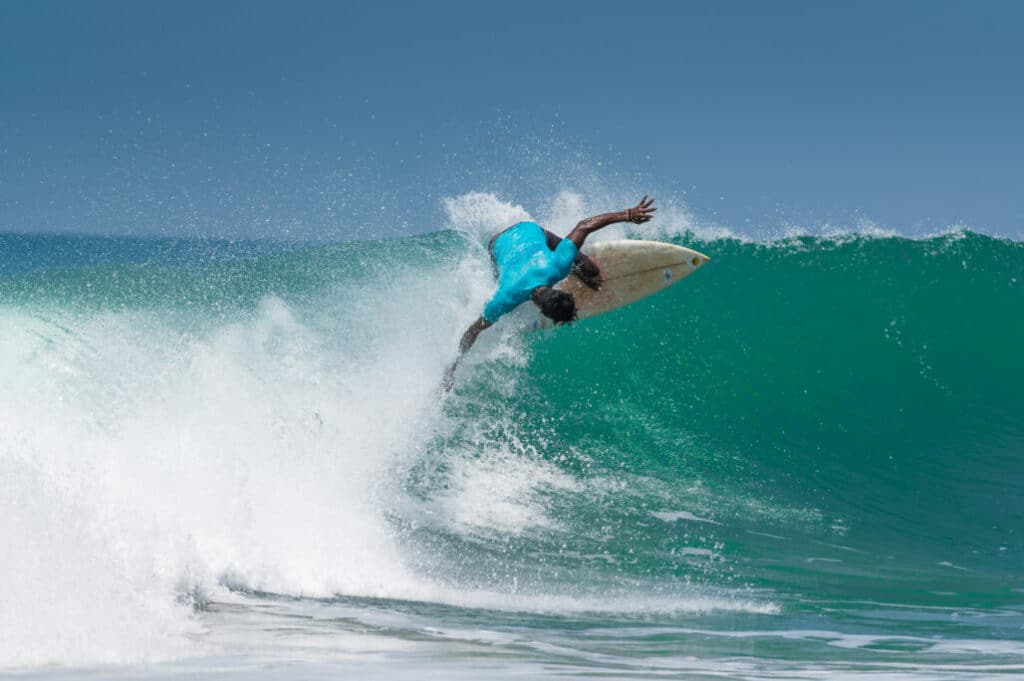
The Kerrupt Flip is another aerial manoeuvre that combines a frontside air with a flip. To perform a Kerrupt Flip:
- Gain speed and approach the wave at an angle.
- Launch your board off the lip with your back foot.
- Rotate your body forward while flipping your board.
- Spot your landing and prepare for impact.
- Stick the landing with your feet aligned over your board, completing the flip.
Rodeo Flip
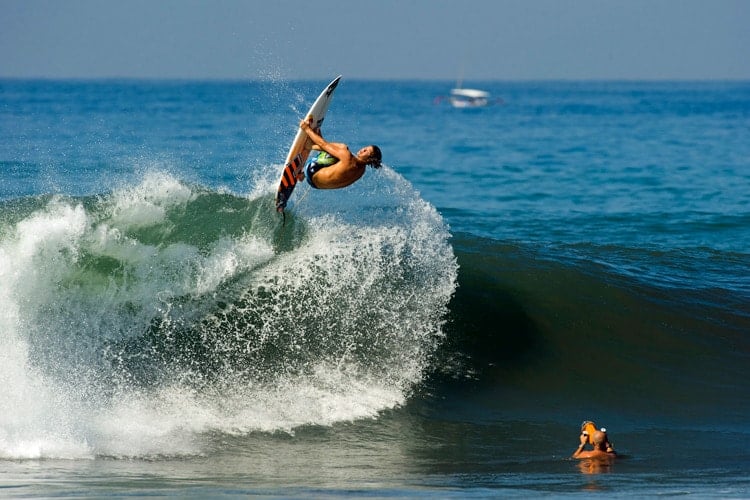
The Rodeo Flip will challenge even the most experienced surfers. This trick involves a 180-degree spin combined with a backflip. To execute a Rodeo Flip:
- Approach the wave with speed and hit the lip at an angle.
- As you reach the highest point of your air, start a backflip motion, tucking your head and knees.
- Rotate your body 180 degrees while maintaining the backflip.
- Spot your landing and extend your legs.
- Land smoothly and ride away to the sound of applause.
Flynnstone Flip
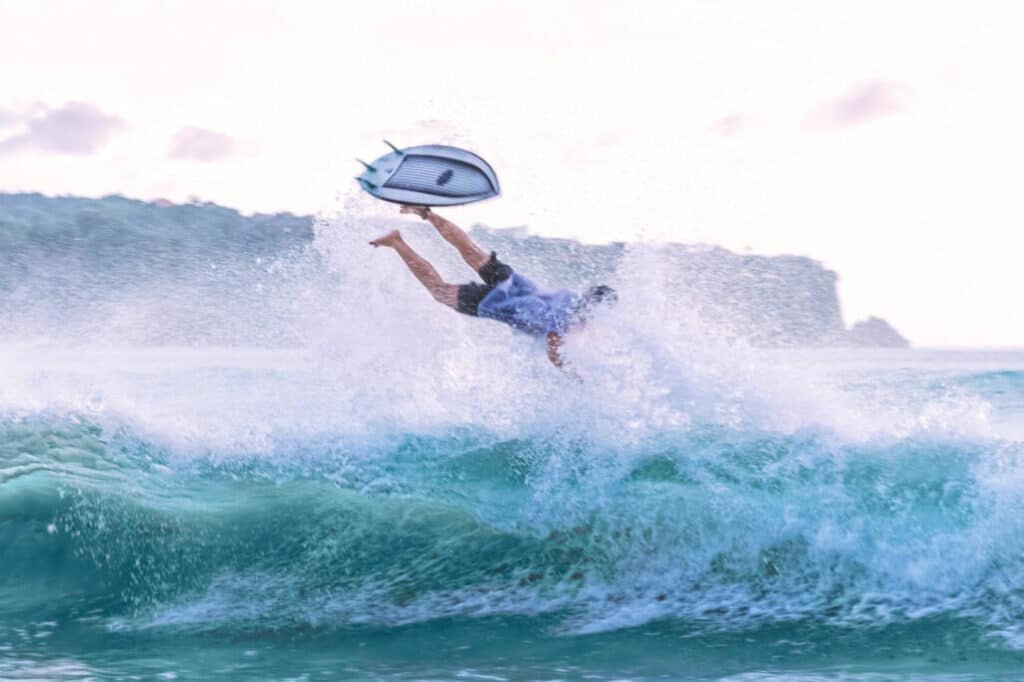
The Flynnstone Flip is a rare and stylish manoeuvre that includes a frontside air and a backflip. To do a Flynnstone Flip:
- Generate speed and target a steep section of the wave.
- Pop off the lip, leading with your back foot and shoulder.
- Tuck your head and initiate a backflip motion while maintaining frontside rotation.
- Keep an eye on the landing and prepare for impact.
- Land with finesse and ride out in style.
Superman
The Superman is a fun aerial trick that, as the name suggests, has the surfer mimicking the famous superhero’s flying pose. To pull off a Superman:
- Approach the wave at full speed.
- Launch into the air and extend your body parallel to the water.
- Hold onto the rails of your board while keeping it beneath you.
- Tuck your legs in and spot your landing.
- Land swiftly, regaining your regular stance and continuing your ride.
Kickflip
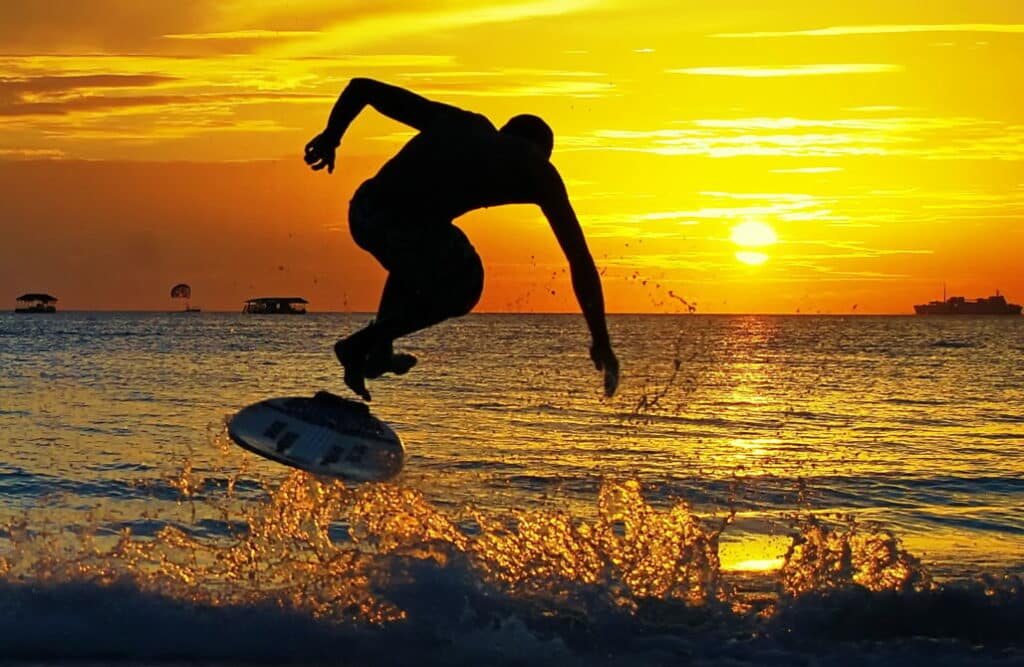
Last but not least, the Kickflip is another advanced trick borrowed from skateboarding. To successfully perform a Kickflip on your surfboard:
- Approach the wave with speed and aim for the lip.
- Launch into the air using your back foot’s pressure.
- Flip your board horizontally by flicking your front foot.
- Keep an eye on the rotation and prepare to catch the board with your feet.
- Land smoothly and ride away with a new sense of accomplishment.
Whether you try one, a few, or all of these thrilling manoeuvres, we believe that pushing your limits and expanding your repertoire is essential in the world of surfing. We hope to see you out in the lineup, trying these advanced tricks with confidence and skill!

Board Control and Balance
Learning how to control and balance on your surfboard is fundamental to mastering a range of surfing techniques and manoeuvres. In this section, we’ll focus on several skills that will help you become more confident in your board control and balance: Hang Five, Hang Ten, and Rail-to-Rail.
Hang Five
Hang Five is a classic longboard manoeuvre that involves stepping towards the front of the surfboard and extending one foot off the nose, letting your toes hang over the edge. To execute Hang Five, follow these steps:

- Ensure wave conditions are suitable for longboarding and that your board has enough glide to perform this manoeuvre.
- Take off on a wave, and once you’re stable, begin to shuffle your feet towards the nose of the board.
- Shuffle your back foot forward, and simultaneously lift your front foot, placing it near the nose with just your toes hanging over the edge.
- Maintain your balance by keeping a low centre of gravity and adjusting your weight as necessary.
As you hone your Hang Five skills, you’ll begin to understand how even the subtlest movements can impact your board control.
Hang Ten
Hang Ten is an advanced step up from Hang Five, often considered the pinnacle of longboard manoeuvres. Now, both feet are placed at the nose of the board, and all ten toes hang over the edge. To execute Hang Ten, follow these steps:
- Start with a Hang Five position to gain stability and confidence.
- Once comfortable, slowly shuffle your back foot forward, next to the front foot, with both toes hanging over the nose.
- Bend your knees and maintain a low centre of gravity for optimal balance.
- Keep your arms out for additional stability, and remember, subtle weight adjustments are critical in this manoeuvre.
Hang Ten, although challenging, is incredibly rewarding once achieved, showcasing your true expertise in board control.
Rail-to-Rail
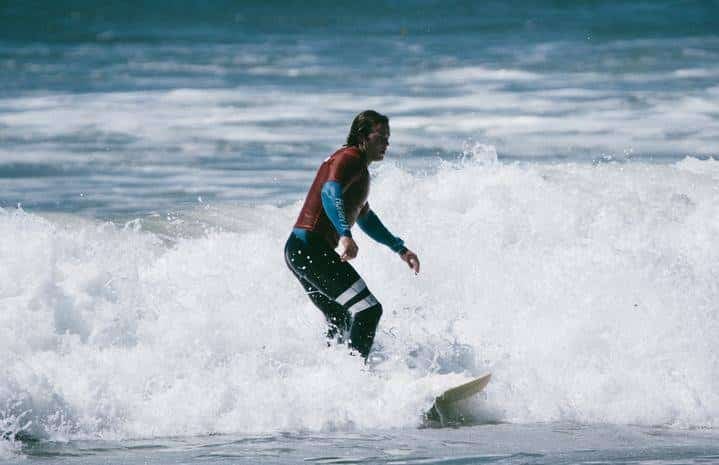
Rail-to-Rail balance is essential for overall surfboard control, increasing your manoeuvrability and ability to navigate waves. Working on this skill involves shifting weight from one rail (side) of the board to the other for sharper turns or more fluid riding. Steps to improve your Rail-to-Rail balance are as follows:
- Begin by gaining speed and stability while riding a wave.
- Initiate the Rail-to-Rail motion by shifting your weight from your heels to your toes or vice versa.
- Maintain your centre of gravity, keeping your knees bent and your body positioned over the centre of your board.
- Focus on smooth transitions from one rail to the other, using your upper body and arms to help navigate the shifts.
By mastering these techniques, you’ll experience increased fluidity in your surfing, pushing yourself to explore even more advanced manoeuvres on the waves.
Combining Hang Five, Hang Ten, and Rail-to-Rail in your surfing skillset will elevate your board control and balance, ultimately allowing you to take on a full range of other techniques, including bottom turns, cutbacks, and floaters. Remember, practice makes perfect, so stay committed and persist with these board control and balance manoeuvres to unlock the full potential of your surfing abilities.

Famous Surfing Icons and their Signature Moves
When it comes to surfing, there are legendary figures who have left an indelible mark on the sport. Their awe-inspiring and unique moves have inspired countless surfers to push their limits on the waves. In this section, we’ll cover three such surfing icons and their incredible signature moves.
Kelly Slater
Kelly Slater is considered one of the greatest surfers of all time, with a record 11 world championships under his belt. His outstanding prowess on the water comes from his impressive array of surfing manoeuvres.
Here are some of his signature moves:
- 360 aerials: Kelly can generate ample speed and rotation, performing a full 360-degree spin in the air.
- Cutback: A powerful, sweeping turn back towards the curl of the wave that is a hallmark of Slater’s style.
To execute a 360 aerial like Kelly, gather speed down the line and aim for a steep section of the wave as your launch ramp. To perform a cutback, angle your board towards the shoulder and lean into a sweeping arc while maintaining your speed.
Jordy Smith
South African surfer Jordy Smith is another force to be reckoned with in the surfing world. Combining incredible power with exceptional agility, Smith executes revolutionary moves that leave spectators in awe.
Check out some of his standout moves:
- Rodeo flip: An aerial manoeuvre inspired by snowboarding, involving a spin and a flip.
- Alley oop: A move where the surfer launches into the air and spins 180-degrees, landing in the same direction they took off.
For the rodeo flip, gather speed and find a steep ramp to launch off. During the aerial, initiate a backflip while spinning your body. To execute an alley oop, find a ramp section and launch off the lip with enough rotation to land back in the same direction.
Tom Curren
American surfing legend Tom Curren is famous for his graceful style, accentuated by his smooth rail-to-rail transitions and impeccable wave selection.
Some key moves in Curren’s repertoire include:
- Bottom turn: The foundation of every manoeuvre, Curren’s bottom turn sets him up perfectly for each subsequent move.
- Floater: With unparalleled ease, Curren glides over the breaking lip of the wave, suspending himself in time and space.
To emulate Curren’s bottom turn, bend your knees, compress your body and drive off the bottom of the wave with weight on your inside rail. To perform a floater, pick a section of the wave where the lip is starting to break and ride up the face of the wave, maintaining your speed and balance as you glide over the lip.
As we continue to explore various surfing techniques, let these trailblazers inspire you to try something new on the waves. Remember, practice makes perfect, and even the legends once started as beginners. So, whether you’re a veteran or a newcomer, it’s always worth taking the plunge and honing your skills on the swells.
Conclusion

As we’ve explored this ultimate list of surfing techniques and manoeuvres, we hope you’ve discovered something new, and it’s encouraged you to challenge yourself in the water. From bottom turns to cutbacks, floaters, and more daring moves such as rodeo flips, these techniques will serve you well as you take your surfing to new heights.
Always remember that practice makes perfect, and mastering these techniques takes time, patience, and dedication. So, hang on tight, and don’t be discouraged if you don’t nail every move right away.
To help you along the way, let’s recap some of the techniques and steps we’ve mentioned:
- Bottom turns: The foundation of many surfing manoeuvres, bottom turns involve shifting your weight on the board, engaging your rails, and positioning your body for your next move.
- Cutbacks: Turn your board sharply back towards the breaking wave to regain speed and power, while maintaining fluidity and control.
- Floaters: Ride over the top of the breaking wave, balancing on the foam, and then drop back down to the face of the wave as it recedes.
Remember, whether you’re a beginner or an experienced surfer, these techniques are designed for surfers of all abilities. So, gear up and get ready to ride those waves with style and precision.
We hope that, as you embark on your surfing journey, or continue to hone your skills, these techniques and manoeuvres will become second nature. You’ll not only grow as a surfer, but also develop a deeper appreciation for the constantly evolving art of wave riding.
So, there you have it – our ultimate list of surfing techniques and manoeuvres to get you out there, riding the waves like a pro. Happy surfing!
Sharing is caring!


